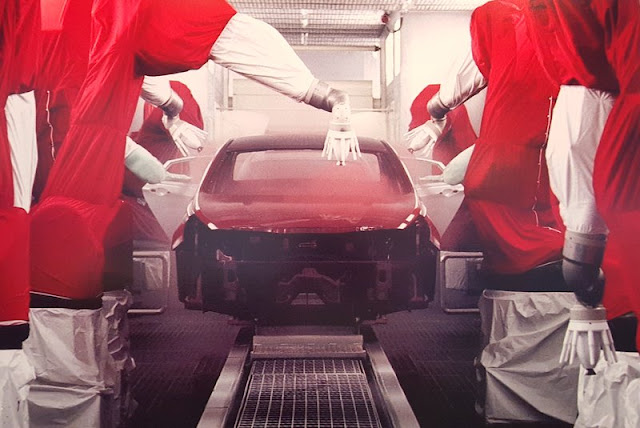While we are camping in one spot, we like to explore the big cities (like Montgomery). But we also really like the smaller towns too. So we spent some time looking around towns like Prattville, Alabama. After visiting their little museum, we walked down the historic Main Street to the park at the end of the street. The falls over Autauga Creek made a very industrial view of what was once Pratt Industries. Home to the leading manufacturer of cotton gins below the Mason-Dixon line, there were several other factories here in the 1800's.
We finished our walk through Prattville on the Creek Trail, then headed down the road to Wetumpka. The Coosa River flows through this town, and we walked the trail beside the water. We thought it was interesting that the Coosa River bridge separated the beautiful white church on the right from the town's first jail on the left. Denisa was a little disappointed at the side of the river that Mark landed on.
Another road trip in the opposite direction took us to Selma, Alabama. Since the movie entitled, "Selma" came out last year, there has been more awareness of the group that made the 54-mile walk from this little town to the state capitol in 1965. We stopped by the National Interpretive Center between the two towns to watch the video and learn from the historical displays about the march.
The Edmund Pettus bridge was made famous from the first attempt of a march that ended when the group met the county sheriff as they reached the top of the bridge on March 7, 1965. This day became known as "Bloody Sunday" because of the sheriff and patrol's attempts to turn the crowd back with night sticks and tear gas.
Today we saw a prettier side of the bridge, framed by the wildflowers along the river front.
Another landmark in town is the Brown Chapel African Methodist Episcopal Church. Built among the low-income housing funded by the George Washington Carver Foundation in the 1950's, it was here that the march was planned and where the walking began.
The second attempt at making the 54-mile march to Montgomery was successful, due to the protection of 2,000 national guardsmen accompanying the group out of Selma. The march to Montgomery took four days, and the group swelled to 25,000 by the time they reached the Alabama capitol steps. After the national attention brought by the march, President Johnson signed National Voting Rights legislation. We heard a tour guide explain that they changed Martin Luther King Jr.'s quote from "I Had a Dream" to "I Have a Dream" to bring his ideas into the present.
We found the town of Selma to be a dichotomy, with very sad areas just blocks away from fine antebellum homes. In the middle of town we discovered the Old Live Oak Cemetery. Filled with tombstones from the 1800's shaded by spanish moss draped trees, it was a beautiful place to take pictures.
As we meandered around the cemetery, we found a group assembling close to the confederate soldier memorial. There is a large number of confederate soldiers buried here in Selma.
We found the group was readying for the ghost walks scheduled for this evening. Actually members of the local Daughters of the Confederacy, they were two of the "ghosts" that would be hiding by the tomb stones. The ghost walk is a fundraiser in which ticket holders would be escorted through this old cemetery to hear stories from re-enactors about the person buried there.
We got some private tour information from the man that designed the memorial area where we were standing. He pointed out the grave of Elodie Todd Breck. The wife of a Confederate officer, she was also the sister-in-law of Abraham Lincoln. She was allowed to travel to see her family in the north, and used that as an opportunity to smuggle medicine back to the south for the confederate soldiers.
We visited other parts of the cemetery, reading headstones like the one below of a 23-year-old Mother from the 1800's that was memorialized by her loving husband.
With all this history, we also got to do some very modern touring. South of Montgomery there is a Hyundai manufacturing plant that produces a new vehicle every 48 seconds.
When we checked for tour openings, we found they were booked up for a month. But when the woman at the visitor center checked, she happened to find two vacancies for us. She commented that she had checked the web site for many people, but this was the first time she had actually found an opening. We must live a charmed life!
They produce two different cars here in Alabama--the Elantra (above) and the Sonata (below). Again, we were a little disappointed that no free factory tour samples were given at the end of the tour.
No photos were allowed inside the manufacturing plant, but Denisa did take some pictures of the pictures in the visitor center. This one is of the automated paint process. Denisa thinks the robots looks like a team of huge headless football players spraying on the paint.
One of the main things we learned from our tour is the correct pronunciation of the word Hyundai. Because we had lived at the Hyundai Foreigner's compound in South Korea in October, and toured the Hyundai Heavy Industries plant there, we should have already known this. But now we know for sure that the word "Hyundai" rhymes with "Sunday."
So we continue to learn every day!
















No comments:
Post a Comment